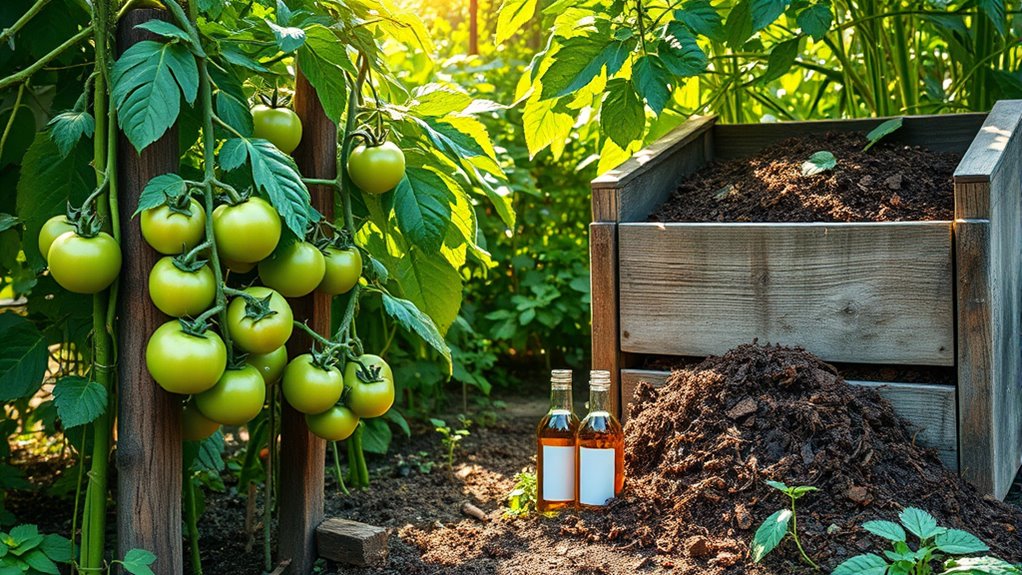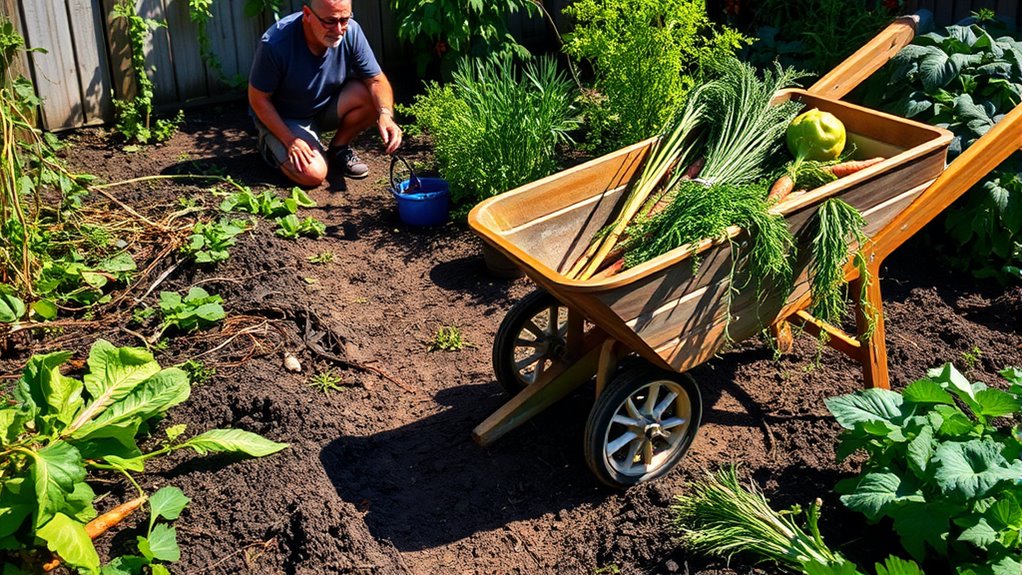Organic gardening isn’t as simple as it looks. Success takes patience, as soil and plant health develop slowly, and weeds can be stubborn and invasive. Pest control is more complex than spraying chemical-free solutions; it requires understanding beneficial insects and crop rotation. Fertilizing needs careful management, and costs can add up quickly. Plus, the effort involved in planning, weeding, watering, and maintaining your garden is greater than you might expect. Keep going, and you’ll discover all the challenges and rewards involved.
Key Takeaways
- Organic gardening requires patience; quick results are unrealistic, and soil health develops gradually over time.
- Weeds with deep roots are highly persistent and require ongoing, strategic removal efforts.
- Achieving pest control naturally involves multiple methods like crop rotation, companion planting, and beneficial insects.
- Proper soil testing and gradual nutrient enrichment are essential for healthy plant growth and avoiding over-fertilization.
- Consistent planning, effort, and patience are key, as organic gardening is a long-term process with ongoing maintenance.
The Myth of Instant Success

Many new gardeners expect quick results, but the truth is that organic gardening requires patience. One common mistake is falling for composting myths that promise instant nutrient-rich soil, which isn’t realistic. Composting takes time, and rushing the process won’t produce the healthy soil your plants need. Additionally, understanding soil health is crucial, as it develops gradually and is fundamental to successful organic gardening. Similarly, watering misconceptions can lead to disappointment; overwatering or underwatering can hinder growth. Organic gardening isn’t a quick fix—it’s about nurturing your soil and plants over time. Expect slow progress at first, but trust that consistent effort will pay off. Avoid the temptation of shortcuts or false promises, and focus on proper practices. With patience and persistence, you’ll see your garden thrive naturally, proving that good things really do take time.
Pest Control Is More Complex Than It Seems

Pest control isn’t as simple as it seems; it involves using natural deterrents and understanding how different strategies work together. Crop rotation helps break pest cycles, while beneficial insects keep harmful pests in check naturally. By balancing these methods, you’ll create a healthier, more resilient garden. Additionally, understanding the decoding of modern slang can help gardeners communicate more effectively about their practices online and stay connected with youth culture trends.
Natural Pest Deterrents
Natural pest deterrents offer a safer, eco-friendly way to protect your garden, but they require understanding that pest control isn’t as simple as it seems. You’ll find that techniques like companion planting can naturally repel pests by pairing plants strategically, creating a protective barrier. Incorporating pest-resistant varieties into your garden helps reduce the likelihood of infestations without chemicals. These varieties are bred to withstand common pests, making them a smart choice for organic gardening. However, relying solely on natural deterrents isn’t foolproof; pests can still find their way in. Combining multiple methods, such as companion planting and pest-resistant plants, increases your chances of keeping pests at bay. Remember, patience and observation are key to finding the right balance for a healthy, thriving garden.
Crop Rotation Strategies
Implementing effective crop rotation strategies is a vital step in managing pests naturally, but it’s important to recognize that pest control isn’t as simple as swapping plants each season. You need to take into account how different crops interact with pests and the soil. Incorporate companion planting and cover cropping to enhance pest resistance and soil health. For example, rotating legumes with leafy greens can reduce soil-borne pests, while cover crops like clover suppress weeds and improve fertility. Use this table to plan your rotations:
| Crop Type | Benefits |
|---|---|
| Legumes | Fix nitrogen, reduce pests |
| Leafy greens | Break pest cycles, improve soil |
| Cover crops | Suppress weeds, protect soil |
A thoughtful rotation minimizes pest buildup and keeps your garden healthy. Crop rotation is a key component of sustainable gardening practices that can lead to long-term success.
Beneficial Insects Role
Did you know that beneficial insects play a crucial role in maintaining a healthy garden ecosystem? They help control pests naturally and support pollinator partnerships for better crop production. To effectively use beneficial insects, you need to focus on beneficial insect identification and understand their roles. Here are three key points:
- Recognize helpful insects like ladybugs, lacewings, and parasitic wasps.
- Avoid broad-spectrum insecticides that harm these beneficial allies.
- Create habitats such as flowering plants to attract and sustain beneficial insect populations.
- Understanding divorce process details in various states can help gardeners who are managing shared property or legal matters related to land ownership.
Soil Preparation Takes Patience and Knowledge

Before planting, you need to understand your soil’s needs through proper testing. Enriching your soil with the right nutrients boosts plant growth and health. Patience and knowledge are key to preparing a fertile foundation for your organic garden. Incorporating soil testing can help identify deficiencies and guide your fertilization strategies for optimal results.
Nutrient Enrichment Techniques
Enhancing soil nutrients is a essential step in organic gardening that requires patience and informed techniques. To boost soil health, consider these methods:
- Brew and apply compost tea regularly to introduce beneficial microbes and nutrients directly to the soil.
- Use foliar feeding by spraying diluted organic liquid fertilizers on plant leaves for quick nutrient absorption.
- Incorporate organic amendments like compost and aged manure to slowly enrich your soil over time.
These techniques help maintain nutrient levels without synthetic chemicals. Compost tea provides a living boost, while foliar feeding offers immediate support for plants during growth spurts. Patience is key—consistent application improves soil fertility naturally, ensuring your garden thrives in harmony with nature.
Proper Soil Testing
Understanding your soil’s current condition is essential for successful organic gardening, and proper soil testing provides the accurate information you need. By analyzing soil composition, you can determine nutrient levels, pH balance, and drainage capacity. Using test kits simplifies this process—you can perform basic tests at home or send samples to a lab for detailed analysis. Test kits often include pH meters and nutrient indicators, giving you quick, actionable results. Knowing your soil’s specific needs helps you avoid over- or under-fertilizing and guarantees ideal plant growth. Regular testing also tracks soil health over time, allowing you to make informed amendments. Taking the time to test your soil correctly sets a solid foundation for a thriving organic garden.
Organic Fertilizers Require Careful Management

Organic fertilizers can be highly effective, but they require careful management to guarantee your garden thrives. You need to monitor nutrient levels and avoid overfeeding, which can harm plants. To do this effectively, consider these tips:
- Use compost tea regularly to boost soil nutrients without risking over-application.
- Incorporate foliar feeding to provide quick nutrient boosts directly to leaves, especially during growth spurts.
- Keep a gardening journal to track fertilizer timing and amounts, helping you adjust as needed for [ideal / best / maximum / prime / superior] results.
- Be mindful of subtopic 1: family photoshoot fails, as unanticipated weather changes can impact your garden’s health and should be accounted for in your management plan.
Weeds Can Be More Persistent Than Expected

Weeds often prove more persistent than many gardeners expect, quickly regrowing after removal and competing fiercely with your crops for nutrients and water. Their weed resilience lies in deep, invasive roots that invade your soil, making eradication challenging. You might pull a weed today, only to see it sprout again tomorrow. To visualize this, consider the following:
| Weeds’ Root Depth | Effect on Garden |
|---|---|
| Shallow | Easier to remove |
| Deep | Root invasion, harder to control |
| Extensive | Rapid regrowth |
| Invasive | Displaces native plants |
| Resilient | Survives harsh conditions |
Understanding their root invasion capabilities helps you develop better strategies to keep weeds at bay, but persistence remains key. Additionally, recognizing the invasive nature of certain weeds can help gardeners implement more effective control measures.
The Cost of Organic Gardening Can Add Up

While managing persistent weeds requires consistent effort, keeping a thriving organic garden often comes with its own set of expenses. You need to take into account various cost considerations that can add up quickly. To stay on budget, try these budgeting tips:
- Prioritize essential tools and organic fertilizers instead of buying everything at once.
- Use compost and homemade organic amendments to reduce costs.
- Shop for seeds in bulk or during sales to save money long-term.
- Be aware that some organic practices may require additional investments in sustainable gardening practices to maintain eco-friendly growth.
Time and Effort Are Greater Than You Might Think

Maintaining a thriving organic garden requires more time and effort than many beginners expect. Proper garden planning involves selecting the right plants, preparing soil, and scheduling planting dates. You’ll need to stay attentive to harvest timing, ensuring vegetables are picked at peak ripeness. This often means regular watering, weeding, and pest control, which can be time-consuming. To visualize the effort, consider this table:
| Task | Time Commitment | Key Focus |
|---|---|---|
| Garden planning | Initial setup, seasonal | Crop selection |
| Planting | Early mornings, weekends | Soil and seed prep |
| Maintenance | Weekly, ongoing | Watering, weeding |
| Pest control | As needed | Organic methods |
| Harvesting | Peak ripeness, timely | Harvest timing |
Expect to invest significant effort, especially during peak seasons, but the rewards are worth it. Additionally, understanding the time and effort involved can help you set realistic expectations and plan accordingly.
Frequently Asked Questions
How Long Does It Typically Take to See Results in Organic Gardening?
You’ll typically see results in organic gardening within a few weeks to a couple of months. As your compost matures, it provides rich nutrients that boost seed germination and plant growth. Keep in mind, patience is key—your plants need time to establish and thrive. Regular watering, proper composting, and choosing the right seeds will help you notice healthy growth faster, so stick with it!
What Are the Best Natural Methods for Controlling Pests Organically?
Did you know that using natural methods can reduce pest damage by up to 75%? To control pests organically, try companion planting—pairing plants like marigolds with vegetables deters pests naturally. Biological controls, such as introducing beneficial insects like ladybugs, also keep pests in check. These methods work together to create a healthy, balanced garden, minimizing the need for chemical interventions while keeping your plants thriving.
How Do I Determine the Right Soil Amendments for My Garden?
You determine the right soil amendments by starting with soil testing to identify deficiencies and pH levels. Focus on improving soil quality with high-quality compost, which boosts nutrients and organic matter. Observe your garden’s growth and health, adjusting amendments as needed. Regular testing and using nutrient-rich compost help create an ideal environment, ensuring your plants thrive organically and stay healthy without synthetic fertilizers.
Are Organic Fertilizers Safe for Children and Pets?
Yes, organic fertilizers are generally safe for children and pets when used properly. You should always follow the label instructions and avoid over-application to reduce any risk of exposure. Keep fertilizers out of reach and wash hands after handling. Prioritizing child safety and pet health means staying informed about the ingredients and opting for certified organic products, which tend to be safer and less toxic.
How Can I Effectively Manage Persistent Weeds Without Chemicals?
Did you know weeds can double in number every few weeks? To manage persistent weeds naturally, try mulching techniques like straw or wood chips to block sunlight and suppress growth. Additionally, companion planting with herbs like basil or marigolds can deter weeds and pests. Regular hand-pulling and maintaining healthy soil also help keep weeds at bay. With patience and consistent effort, you can keep your garden weed-free organically.
Conclusion
Organic gardening promises beauty and bounty, but it demands patience and effort. While you might imagine instant success, you’ll face stubborn weeds and tricky pests. The cost can add up, and soil preparation takes time. Yet, amidst these challenges, you’ll find a rewarding connection to your land and a deeper understanding of nature’s rhythms. Embrace the journey, knowing that the true reward lies not just in harvests, but in the growth you experience along the way.










